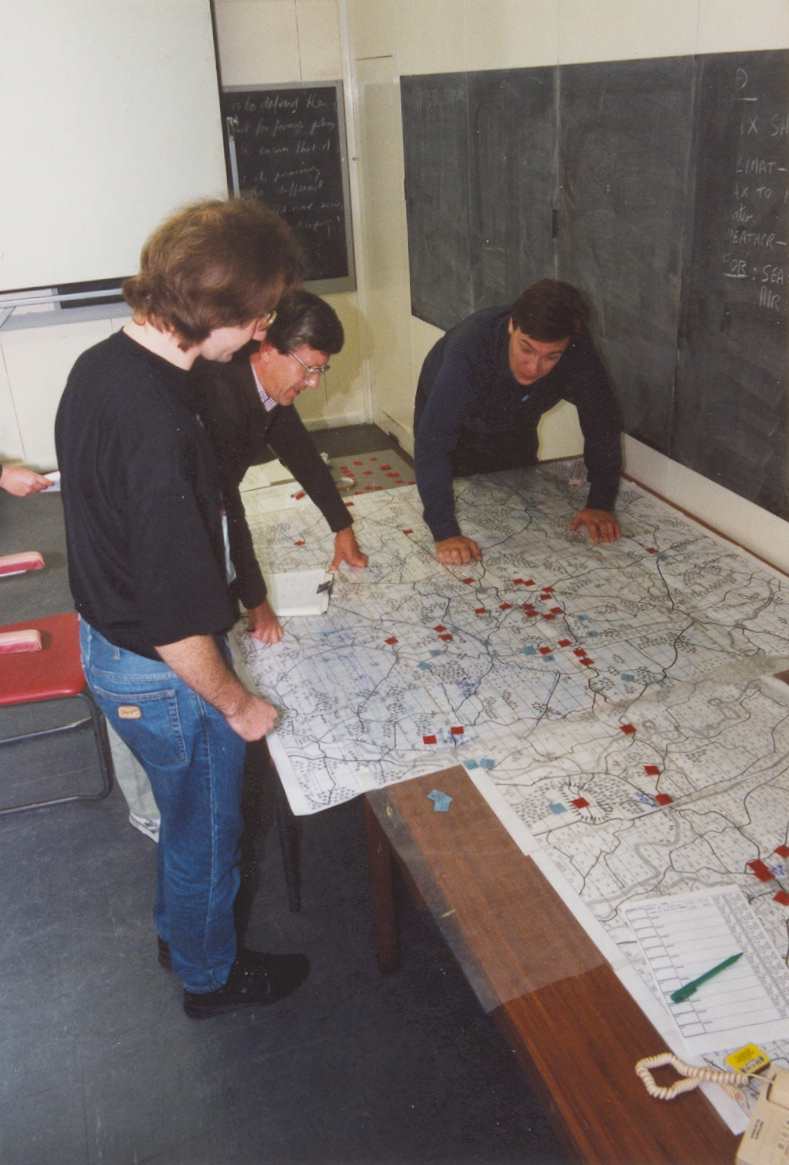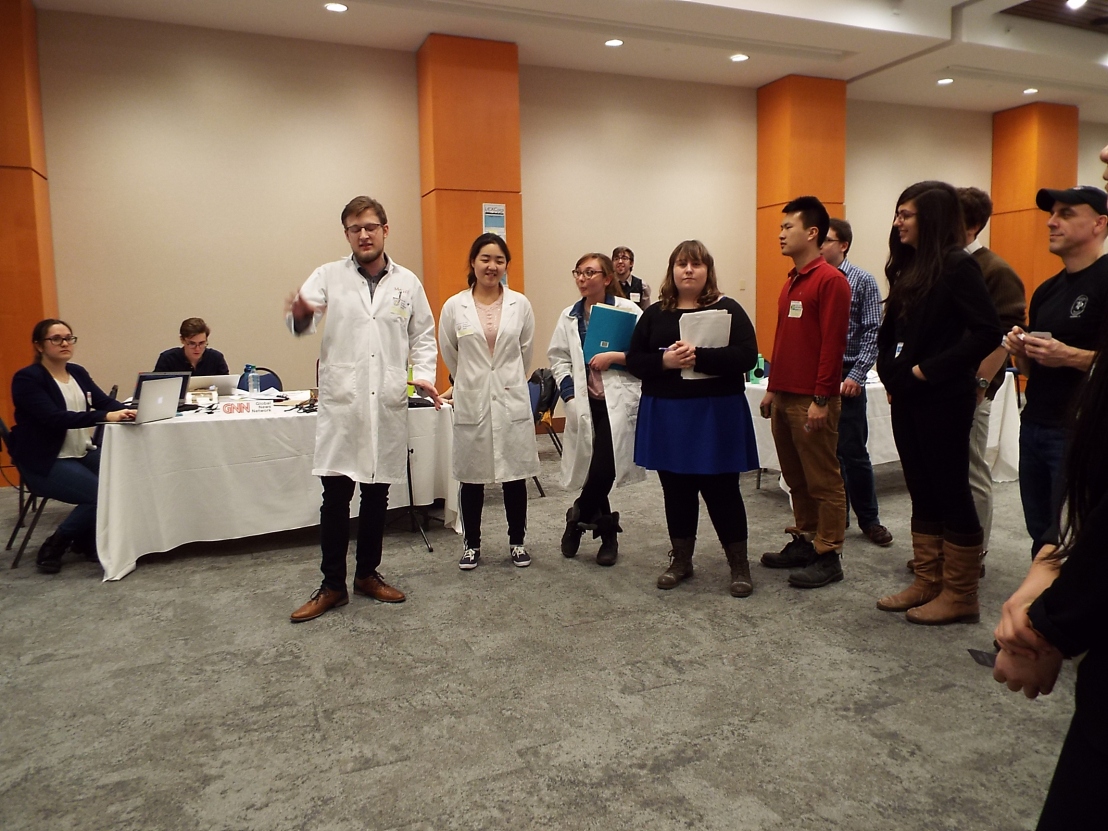Origins of Megagames
The early prototypes of what were to become megagames started with Paddy Griffith in the later 1970s and early 1980s. As a senior lecturer at the Royal Military Academy Sandhurst, Paddy ran large multiplayer wargames for the students and my early involvement with Paddy and large, multiplayer multi-team games was being invited to take part as a member of the control teams.
The first game actually called a megagame was Paddy’s ‘Memphis Mangler‘ Vietnam wargame played in April 1982 with about 30 players, though both Paddy and others (such as the Chestnut Lodge Wargames Group in South London) had been running games that would by our modern definition qualify as a megagame these days. It was Andy Callan who coined the name, saying something like “this isn’t just a wargame, it is some sort of … MEGA-game”

From the outset, for recreational wargamers, the whole idea of these large multi-player games was both startling and very exciting. At that time There was nothing else like it outside the military training environment (and even in the military training environment they were a lot less open to emerging game-play), and those early games by Paddy and, later, Andy Grainger were exceptionally inspirational and really started the development of megagames as we now understand them.
There has, of course been mainstream hobby wargames involving lots of people – but these generally lacked the hierarchies and the team interaction that characterises megagames. Wargames with large numbers of toy soldiers with two sides playing a simple game on the table top (or floor) facing each other would not generally qualify as a megagame.
Through my contact with Paddy I was able to not only see his idea of large wargames put into practice, but also I was invited to help him run operational wargames for cadets at the Sandhurst Academy, and to help Paddy set up and run a wargame for Southern TV’s series Invasion Road in 1979, where we ran a fictitious Warsaw Pact / NATO wargame using the Royal United Services Institute in Whitehall as a venue and memorably with the late Brigadier Peter Young as the NATO supreme commander!
The early 1980s saw a series of imaginative, sometimes quirky, sometimes astonishing megagames run by Paddy, with the help of others. I thoroughly recommend Paddy’s book, Sprawling Wargames for an insight into his philosophy of larger wargames with multiple players. Paddy’s games covered a wide range of historical subjects the French Revolution (in a game called ‘Sans Culottes‘). the 1918 Kaiserschlact Offensive, the Peninsular War (in a game called ‘Tajo‘), the convoy war in the Atlantic (‘Western Approaches’), the Franco-Austrian war (‘Novi‘ in conjunction with myself), and the opening moves of WW1 (‘Guns of August‘). Paddy brought a professional historian’s attention to detail and a truly creative instinct for games to his megagames.
These early games inspired Andy Grainger to turn his own highly respected and thorough research skills to the genre, and he produced a very successful series of well-written and structured world war two historical megagames, based around the Battle of Kirovograd.

Andy’s example proved the final inspiration for me to start running my own games on the same scale and my first megagame “Blood & Thunder” – a huge 60 player piratical naval /role playing game – in 1987. This was historical, and loosely based on Morgan’s fleet raids on the Spanish Main. It had perhaps a higher degree of role playing and plot than previous megagames, and was built around the team concept, with each team representing a ship’s crew. The main action was using model ships on a huge floor model in the Woolwich Hall in Sandhurst.
This kicked off a long run of games that continues to this day.
The early 1990s saw the first properly collaborative game design, with a megagame called Springtime for Hitler, and the creation of the loose association of megagame designers, now known as Megagame Makers. Springtime was 180 player game about the campaign in France and the Low Countries in 1940. Graham Attfield, Brian Cameron, Andy Grainger, Steve Hale, Terry Martin, and myself put together a large and complex military / political game, and set the scene for future collaborations in megagame design.
We established that it didn’t necessarily need a single talented and enthusiastic individual to produce a successful game, and that notion probably encouraged many of today’s designers to take the plunge, at first, in collaboration with others.
Other Influences
Of course, in the professional wargaming field (in government and defence circles) the multi-player political / operational game has been in existence for decades or longer . There were (and are) many elaborate wargames played by the US military and the RAND Corporation during the late 1950s to the 1980s, and these were (and still are) used to inform policy within government.
I was fortunate, in the 1980s, to be able to access quite a lot of the literature of those games through the Ministry of Defence library.
In addition there have been political and crisis games run in many University politics departments, and these routinely form part of the study programmes.
Many of our megagamers (and some designers) have had experience of these and bring that experience to their game designs.
In the UK hobby wargames world, the megagame concept came about about as a cross-over from Dr Paddy Griffith and some members of the group he founded in 1980, “Wargame Developments”.
The initial idea was to use the techniques of the military command post exercise (CPX) in playing hobby wargames. Paddy experimented successfully with the multi-room wargames using closed game systems, and ran a number of games for non-military audiences – most notably his game of ‘Sealion‘ and his NATO / Warsaw Pact game for the 1979 TV series ‘Invasion Road‘ for Southern Television.
Although the detail and the way these were put into practice has altered over the years – the basic tenets form the key central characteristics in many of the modern megagames.

Board game designs have been influential too – particularly where political and economic factors are in play. The growth of the commercial board games over the last decade has been meteoric – particularly the popularity of euro games. And this, coupled with the expansion of social board gaming has created a demographic of ‘game literati’ who form a large proportion of the present population of megagamers.
Also Kriegspiel has been important Bill Leeson’s involvement in bringing the modern Kriegspiel back into the light, and the natural similarities between the Kriegspiel and the operational megagame.
The original Reiswitz Kriegspiel has much in common with the modern operational megagame – they both involve maps gaming, and the movement of units over time, hidden movement and command and control structures. Players of kriegspiel often migrate easily to operational megagames because the feel is very similar.
Computer games and especially Real Time Strategy (RTS) games have been influential for a number of games. The computer game has massively altered from its early pixillated simplicity on the BBC, Commodore 64 or Spectrum. Even then, the classic game ‘Arnhem’ game by SSI for the Spectrum was the initial inspiration of the early operational world war 2 megagame ‘Operation Market Garden‘.
Modern computer games have many of the features that can be found in the megagame – once you get behind the photo-realistic graphics. Games which encourage multiplayer interaction in particular team play – for example famous MMORPGs such as World of Warcraft – have encouraged team-based play and even hierarchies of command and control have evolved, though this is not a central tenet of the game design.
Familiarity with cooperative play is growing, and the best example of this is Artemis, the starship bridge crew simulator. This creates, over a computer network, an excellent real-time simulation of a starship bridge with players operating key control stations and who must communicate and cooperate to run their ship. The system even allows up to six ships to cooperate, necessitating a hierarchy and an admiral and/or squadron commanders.
And, of course, most recently, the well-known Watch the Skies series of megagames was inspired by the 1994 classic game UFO Enemy Unknown developed by Mythos Games and MicroProse.
Game Theory has had its place too. As the megagame idea developed, so designers started to draw in ideas from game theory – not just the mathematical aspects, but more qualitative ideas concerned with the psychology and sociology of game play.
This has been supplemented by ideas drawn from more recent literature on game design that has arisen from the growth of game design as a subject taught at university (on the back of the explosion in the computer games industry). Academic professors of Game Design are, as professors do, writing about their subject in extremely interesting, and entertaining, ways and the literature is growing daily. I particularly like Rules of Play by Katie Salen and Eric Zimmerman.. Also recommended are The Art of Game Design: A book of lenses and A Theory of Fun for Game Design.

Management theory has also been an influence. There are vast mountains of books on management theory, and life would be far too short to have read them all, let alone apply them to megagame design. However, a number of ideas have been influential – in particular the very effective communications theories of MIT Professor Fred Kofman in his book ‘Conscious Business‘. Don’t be put off by the ‘business’ look of the book, it is, for me, one of the best books on interpersonal communication out there. And megagames are all about interpersonal communication.
Some basic ideas on the operation of hierarchies, team formation and even Maslow’s hierarchy of needs have been applied in the design of megagames.
Leadership and communications theory has been influential too. Megagames are about leadership. It will come as no surprise that theories of leadership have been influential in developing and designing game briefings and setting the challenges for players leading teams (even though they might not be aware that in playing what appears to be a fairly simple game role is in fact giving them access to valuable practice for leadership.)






